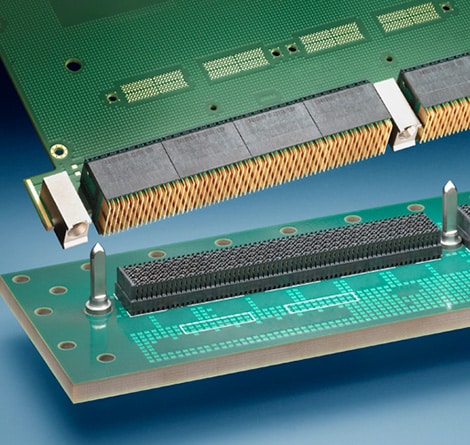

Standardizing connectivity for military embedded systems can now become a reality with the new SOSA™ standards.
The Sensor Open Systems Architecture (SOSA) Consortium is developing a common framework for transitioning sensor systems to an open systems architecture, based on key interfaces and open standards established by industry-government consensus. These systems will be deployed in platforms across all major U.S. military branches. Using OpenVPX architecture, SOSA ensures interoperability, improved subsystem SWaP-C, and rapid technology upgrades. Below is a Q&A with Global Product Manager, Michael Walmsley, on the emerging SOSA™ technical standards and existing VITA standard.
Q&A with Michael Walmsley, Global Product Manager
How are you involved with VITA?
I currently chair working groups for RF connector modules (VITA 67), higher data rate VPX connectors (VITA 46.30, 31) and XMC 2.0 connectors (VITA 61). I have also worked with TE to build a connector roadmap to support OpenVPX and was recently elected to the VITA Board of Directors.
Are there any specific standards or areas where VITA is actively considering updates?
VITA standards for connectivity are very active. In 2020, we completed VITA 46.30 which takes the VPX connector and defines the product for next gen speeds, supporting data rates to 25Gb/s (TE’s MULTIGIG RT 3 connectors). VITA 67.3 (RF modules) had been revised in 2020 to include higher density interfaces NanoRF and SMPS and is undergoing further updates, tying in with the upcoming release of VITA 66.5 which covers optical modules and hybrid optics/RF. VITA 87 is in process as a new standard for high density MT-based optical interconnect in a M38999 package. VITA 62 power supply standards have expanded to include new connector variants to support 270VDC applications, as voltage requirements increase. And VITA is finishing updates to all XMC (mezzanine card) standards to upgrade speeds and better define connector options. Increases in speed, density and power are driving the evolution of new standards.
Are there any efforts outside of VITA that may impact embedded systems designers in the near future?
The SOSATM (Sensors Open System Architecture) Consortium recently completed the SOSA Technical Standard 1.0. This is a defining effort driven collectively by the US military branches (Navy, Army and Air Force), in collaboration with industry and academia, to standardize sensor systems from the hardware inside the box to the external connectivity. Key benefits will be interoperability of systems and components, reduced costs, broader supply chain, and shorter development times for new systems.
How will SOSA™ standards be different than VITA?
The SOSA™ Technical Standard uses OpenVPX architecture inside the box (leveraging VITA standards), and will use M38999 and other rugged I/O interconnects at the panel. And where a new technology or standard was needed for implementation in SOSA aligned systems, SOSA drove that back to VITA for standardization (examples are RF/optical connector module configurations, high density optical VITA 87, and new VPX slot profiles in VITA 65). SOSA actually takes a subset of the interconnect and hardware architecture standards in VITA to define standard use cases for sensor systems and driving commonality that will be followed for next generation systems.
Need help with your Defense & Military project?


Standardizing connectivity for military embedded systems can now become a reality with the new SOSA™ standards.
The Sensor Open Systems Architecture (SOSA) Consortium is developing a common framework for transitioning sensor systems to an open systems architecture, based on key interfaces and open standards established by industry-government consensus. These systems will be deployed in platforms across all major U.S. military branches. Using OpenVPX architecture, SOSA ensures interoperability, improved subsystem SWaP-C, and rapid technology upgrades. Below is a Q&A with Global Product Manager, Michael Walmsley, on the emerging SOSA™ technical standards and existing VITA standard.
Q&A with Michael Walmsley, Global Product Manager
How are you involved with VITA?
I currently chair working groups for RF connector modules (VITA 67), higher data rate VPX connectors (VITA 46.30, 31) and XMC 2.0 connectors (VITA 61). I have also worked with TE to build a connector roadmap to support OpenVPX and was recently elected to the VITA Board of Directors.
Are there any specific standards or areas where VITA is actively considering updates?
VITA standards for connectivity are very active. In 2020, we completed VITA 46.30 which takes the VPX connector and defines the product for next gen speeds, supporting data rates to 25Gb/s (TE’s MULTIGIG RT 3 connectors). VITA 67.3 (RF modules) had been revised in 2020 to include higher density interfaces NanoRF and SMPS and is undergoing further updates, tying in with the upcoming release of VITA 66.5 which covers optical modules and hybrid optics/RF. VITA 87 is in process as a new standard for high density MT-based optical interconnect in a M38999 package. VITA 62 power supply standards have expanded to include new connector variants to support 270VDC applications, as voltage requirements increase. And VITA is finishing updates to all XMC (mezzanine card) standards to upgrade speeds and better define connector options. Increases in speed, density and power are driving the evolution of new standards.
Are there any efforts outside of VITA that may impact embedded systems designers in the near future?
The SOSATM (Sensors Open System Architecture) Consortium recently completed the SOSA Technical Standard 1.0. This is a defining effort driven collectively by the US military branches (Navy, Army and Air Force), in collaboration with industry and academia, to standardize sensor systems from the hardware inside the box to the external connectivity. Key benefits will be interoperability of systems and components, reduced costs, broader supply chain, and shorter development times for new systems.
How will SOSA™ standards be different than VITA?
The SOSA™ Technical Standard uses OpenVPX architecture inside the box (leveraging VITA standards), and will use M38999 and other rugged I/O interconnects at the panel. And where a new technology or standard was needed for implementation in SOSA aligned systems, SOSA drove that back to VITA for standardization (examples are RF/optical connector module configurations, high density optical VITA 87, and new VPX slot profiles in VITA 65). SOSA actually takes a subset of the interconnect and hardware architecture standards in VITA to define standard use cases for sensor systems and driving commonality that will be followed for next generation systems.

